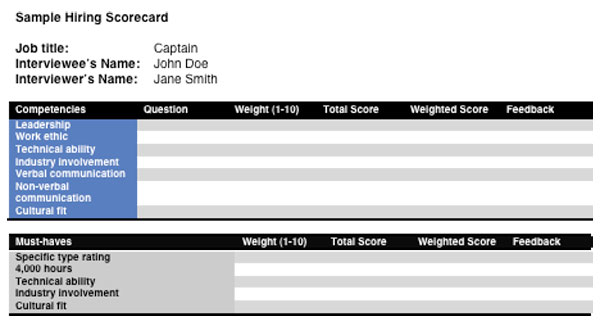What is a hiring scorecard? And how can you create one to bring value to your aviation interview process?
A Hiring Scorecard Lets You be Objective
Essentially, a hiring scorecard helps you treat every interviewee the same.
A scorecard also helps take the emotion (and, thus, the subjectivity) out of the decision-making process. Objectivity—especially during an interview—is tough to summon, and even tougher to maintain. That’s because a job interview, by its very nature, is subjective. So much of what we glean during an interview comes from our gut. After all, our assessment of a candidate’s “cultural fit” or “leadership style” isn’t something we can measure quantitatively.
That’s why using a hiring scorecard can be so valuable. If effectively designed, it will prevent your hiring decision from being affected by outside factors. A scorecard can also put you “in check.” Meaning, it can keep you from gravitating toward one candidate. Despite the fact that they were less experienced than others.
Using a scorecard will also help keep you stay on track and focused. If, during an interview, you feel things are drifting a bit, one glance at your scorecard will help bring you back to the task at hand.
A Scorecard Highlights Behaviors that Relate to Success on the Job
By using a hiring scorecard, you can craft interview questions around the traits associated with current employees who demonstrate success in the position you are hiring for. It will also help you listen for what you really need to know in order to make a sound decision. A good scorecard will rate candidates higher if they display those key traits during an interview. Therefore predicting future success.
Scorecards Minimize Guessing
It’s human nature for even a skilled interviewer to make certain assumptions about whether a candidate will be a good fit or not. (We’re going back to the “gut feeling” tendency again.) A good scorecard takes the guesswork out of hiring by rating each candidate based on their answers. Not on their hobbies, favorite sports teams, colleges . . . I’m sure you get the point.
And as for that “gut check”? If it is telling you “not a fit,” it is probably right and you need to listen to it. Another thing the scorecard does is it helps you temper the “gut feel.” Especially if you like the interviewee and you and he/she really connected. The patina of that feeling can wear off quickly if they are lacking key criteria for success.
What’s Included in a Hiring Scorecard?
Now we know why scorecards are so important to the hiring process. So let’s discuss the elements of one.
An interview scorecard can look very different based on your organization and job fulfillment profile. But, generally, any scorecard needs to have three essential metrics or components:
1. The attributes being scored.
This is the most challenging aspect of designing an effective scorecard. First, with the job itself in mind, decide the most important criteria by which to measure a candidate’s suitability. Then, once you have the criteria (or attributes), determine how to score a candidate on the criteria. Try using a five-point scoring system. What specifically distinguishes assigning a candidate a four instead of a five?
2. A weight assigned to each attribute.
Effectively weighting each attribute is important. Because it enables you to hire for a candidate’s strengths rather than his or her lack of weaknesses. For instance, a captain may have a weight of “5” for a specific type rating. But a weight of only “3” for cultural fit. Whereas an aviation director who has to interact with a lot of different people at the company may have the opposite.
3. Base educational/occupational requirements.
These are relatively straightforward attributes that are easy to score. Examples might include “Earned a B.S. degree in the field,” or “Has an ATP license” or even something as fundamental as “Arrived on time to the interview,” etc.
Building a Hiring Scorecard
So, when all is said and done, what might a typical interview scorecard look like? Well, because the criteria can be represented in such a variety of ways, a scorecard can look completely different from one company or organization to the next. Following is a scorecard that uses a 10-point rating scale. As you’ll see, it has a column for a weighted score, which assigns a point value to a particular criterion as it compares in relation to all the others. This example is merely meant to serve as a guide, but it’s certainly not something you have to copy letter for letter or line for line. Your ideal scorecard might look significantly different.

Manage to the Hiring Scorecard
I hope that you find, as we have at Aviation Personnel International, that using a hiring scorecard adds real value and precision to the interview process. As we’re sure you’ll discover, a well-implemented scorecard benefits the candidates as well as it does the business aviation organization.
One last thing: when you’ve made your decision, offered your candidate the job and are onboarding your new employee, show them the scorecard. Doing so demonstrates to the employee that your hiring decision wasn’t based on whimsy, but on the employee’s actual readiness for the job. It shows your confidence in his or her abilities and also sets clear expectations for their success.

